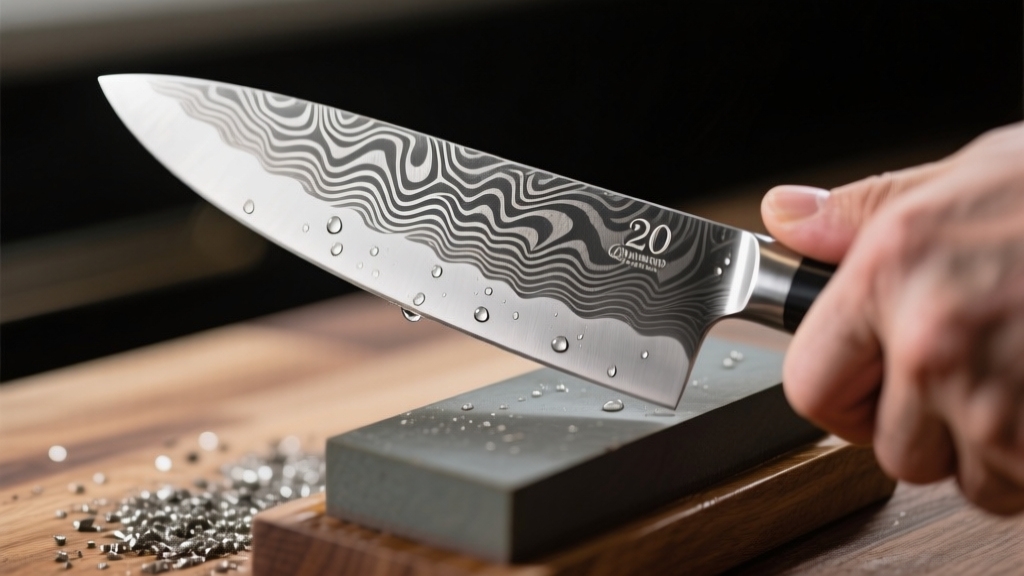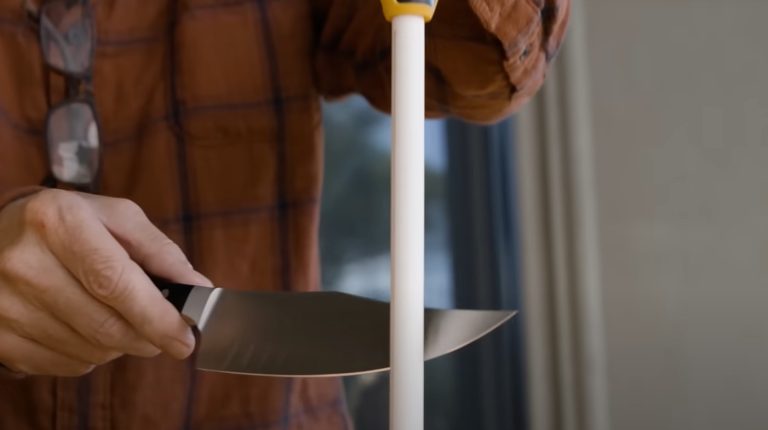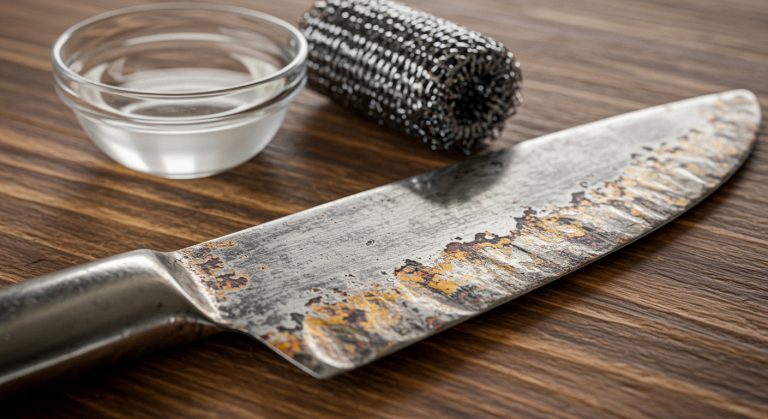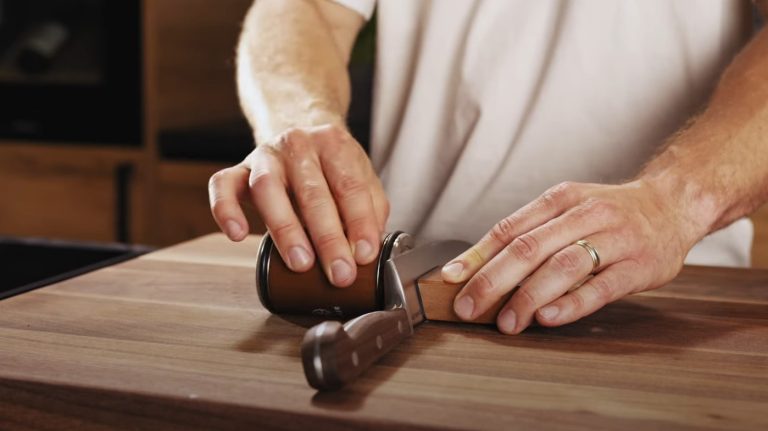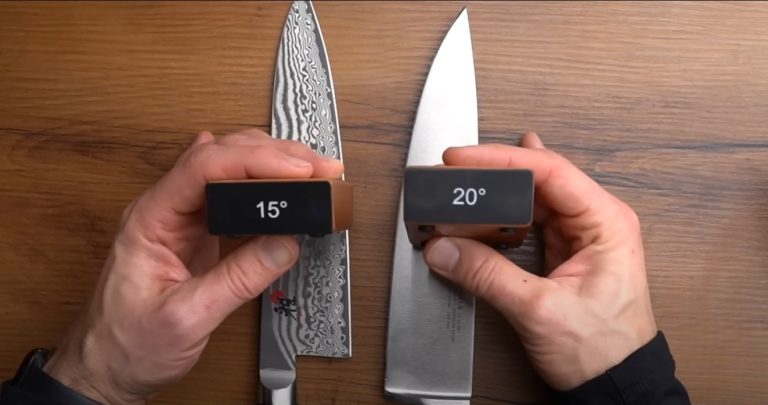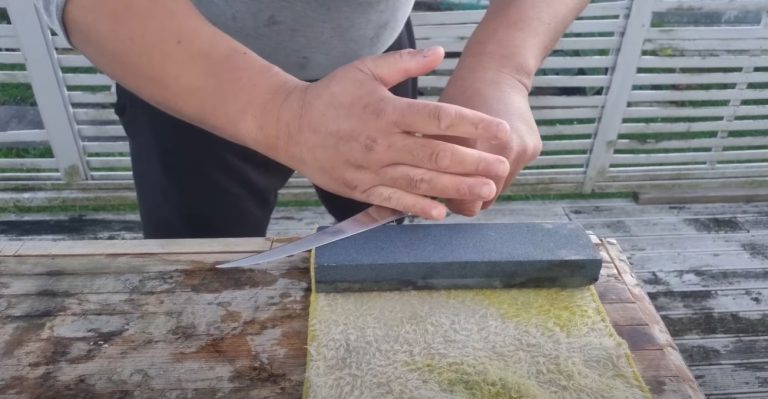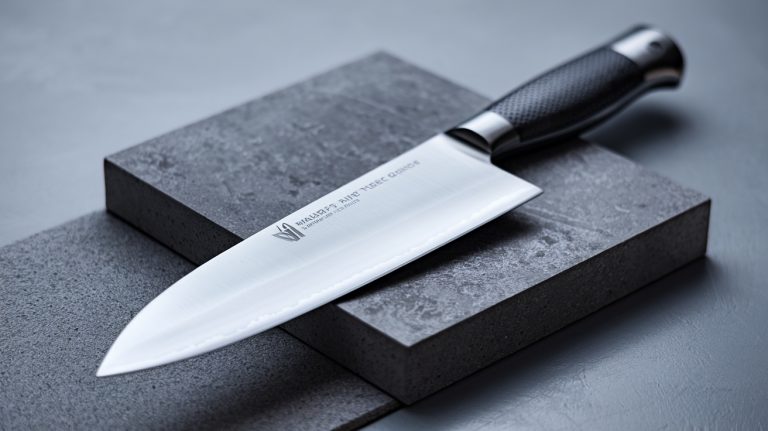How to Sharpen a Damascus Steel Knife Safely and Effectively?
To sharpen your Damascus steel knife, start by securing a water-soaked whetstone on a stable surface to prevent slipping. Maintain a consistent 15°–20° angle while using coarse grit (400-800) to restore the edge, then progressively switch to finer grits (1000-5000+) for polishing without damaging the pattern.
Use gentle pressure and alternate sides to form a balanced edge. Finish by testing sharpness and applying protective oil. Explore further to master every step for lasting sharpness and beauty.
Key Takeaways
- Soak a water stone for 10-45 minutes and secure it on a non-slip surface before sharpening the Damascus steel blade.
- Maintain a consistent sharpening angle of 15°–20° using guides or jigs to preserve the blade’s bevel and pattern.
- Start with medium grit stones (1000-1500) for edge maintenance, then progress to finer grits (3000-8000+) for polishing and pattern preservation.
- Detect and remove burrs by alternating strokes on both sides with light pressure until the edge feels smooth and polished.
- Finish by stropping on leather and testing sharpness with paper, tomato, or arm hair to ensure a refined, sharp edge.
Preparing Your Sharpening Tools and Surface
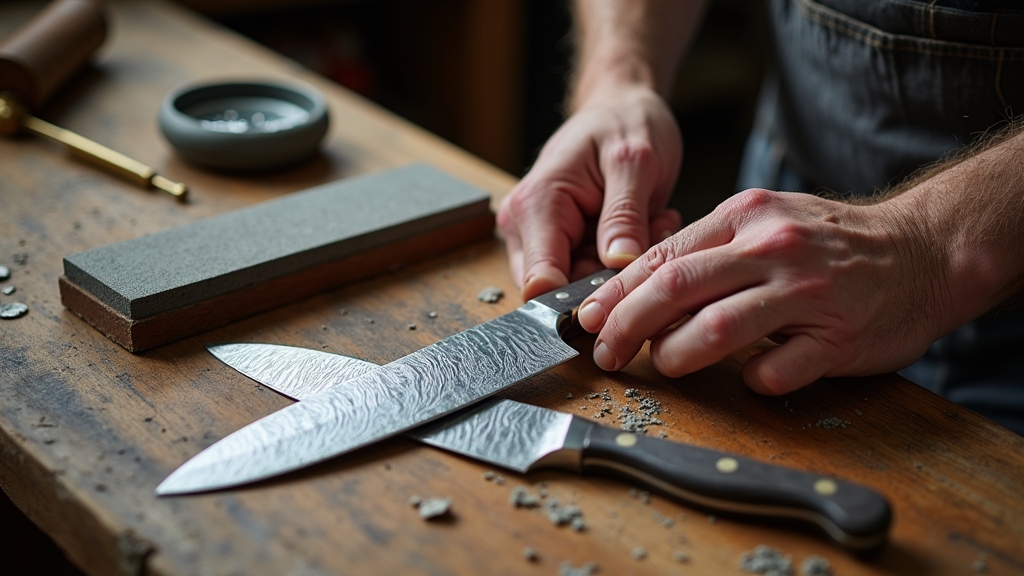
Before you start sharpening your Damascus steel knife, gather and prepare the right tools and setup to guarantee ideal results. Choose a sharpening tool that fits your skill level and needs: manual sharpeners offer control, electric ones deliver speed, and whetstones provide customizable edges but need practice.
Since Damascus steel is made from multiple folded metal layers, it requires special care to preserve both its edge and intricate patterns. Using a cutting board while preparing food can help maintain the knife’s edge longer.
Select the right sharpening tool—manual, electric, or whetstone—to perfectly match your skill and needs.
Prepare your sharpening surface by soaking whetstones in water for 10 to 45 minutes or applying honing oil to oil stones.
Stabilize the stone on a damp towel or non-slip surface to prevent movement. Arrange your tools—stones, sharpeners, honing rods—within easy reach.
Ensure good lighting and enough space to work safely. Confirm your knife’s bevel angle and consider using sharpening guides to maintain consistency.
Selecting the Appropriate Grit for Damascus Steel
When sharpening Damascus steel, choosing the right grit is essential to balance effective metal removal and edge refinement.
Coarse grits quickly reshape dull edges but require follow-up with finer stones to smooth scratches, similar to how the Horl Knife Sharpener uses interchangeable grinding wheels for precise results.
Polishing with high-grit stones not only enhances sharpness but also preserves the blade’s distinctive pattern and finish. The layered structure of Damascus steel influences sharpening techniques, making careful grit selection crucial to maintain both blade integrity and aesthetic appeal.
Grit Ranges Explained
How do you choose the right grit range to sharpen your Damascus steel knife effectively? Start with medium grit stones, typically between 800 and 2000, which balance material removal and edge preservation.
This range, especially 1000 to 1500 grit, is ideal for regular maintenance, refining the edge without over-grinding and protecting the blade’s layered structure.
The unique layering of Damascus steel contributes to its durability and corrosion resistance, which must be considered when selecting sharpening grits. Using whetstones allows for precise angle control to maintain the knife’s original geometry during sharpening.
After shaping, move to fine grit stones from 3000 up to 8000 or higher for polishing and honing. These finer grits smooth the edge, enhance sharpness, and improve durability while preserving the intricate Damascus patterns.
Coarse vs Fine Grit
Although coarse grit stones can quickly restore a severely dull or damaged Damascus steel edge, you should use them sparingly to avoid removing too much material and harming the blade’s distinctive layered pattern.
Coarse grits (400–800) are ideal for major reshaping but require light, controlled pressure and a consistent 15° to 20° angle to prevent chipping or uneven grinding. Damascus knives require careful sharpening to preserve their unique pattern and performance. Using correct sharpening angles during this process maximizes the blade’s performance and longevity.
After coarse sharpening, move to finer grits to refine the edge and minimize abrasive marks. Fine grits (1000–3000) smooth micro-serrations, enhancing sharpness while protecting the intricate Damascus pattern.
Polishing With High Grit
After refining the edge with fine grit stones, you’ll want to focus on polishing to bring out the full beauty and sharpness of your Damascus steel knife. Selecting the appropriate grit is key: start polishing with 1000–3000 grit stones to refine the edge and progress to 5000+ grit for a mirror finish that enhances the Damascus pattern.
Use gentle pressure and maintain a consistent angle to prevent heat buildup and damage.
- Begin with synthetic whetstones around 1000–3000 grit.
- Progress to finer grits (4000–5000+) for mirror polishing.
- Use lubricants like water or honing oil to reduce friction.
- Finish with leather strops to remove burrs and sharpen the edge.
This approach ensures a clean, sharp edge while preserving the blade’s distinctive layered design. For beginners, using a sharpening stone set with versatile grits can help achieve both refinement and polishing effectively.
Securing the Whetstone for Safe Sharpening
Before you start sharpening, secure your whetstone on a non-slip surface like a damp cloth or silicone pad to prevent movement. Many sharpeners feature magnetic holders to enhance stability during use.
If possible, use a dedicated clamp or whetstone holder to keep it firmly in place during use.
This stability guarantees safety and consistent sharpening angles for your Damascus steel knife.
Proper setup helps maintain the correct bevel angle throughout the sharpening process, which is crucial for preserving the blade’s edge integrity.
Non-Slip Surface Options
How can you guarantee your whetstone stays firmly in place while sharpening your Damascus steel knife? Choosing the right non-slip surface is essential to maintain control and safety. Consider these options:
1. Silicone Mats
Their honeycomb texture and perimeter dams provide excellent grip and contain fluids, keeping your workspace clean. Using a stable surface helps you maintain the proper grip on your knife during sharpening.
2. Rubber Mats
Offering high friction and cushioning, rubber mats prevent movement and protect counters, aiding consistent sharpening angles.
3. Wooden Bases with Rubber Inserts
These add weight and stability, elevate the stone for better ergonomics, and combine durability with non-slip features. Many high-quality whetstones are designed with a non-slip base to further enhance stability during use.
4. Adhesive or Suction Pads
Ideal for smooth surfaces, these quick-setup solutions lock your stone in place but might leave residue.
Select a surface that suits your environment to sharpen confidently and safely.
Clamping Methods Overview
When you secure your whetstone firmly, you gain better control and safety while sharpening your Damascus steel knife. Dedicated whetstone holders with rubberized clamps or adjustable screws offer reliable grip and steady angle control, reducing hand fatigue. Due to the sensitivity of Damascus blades, maintaining a stable sharpening setup is crucial to prevent accidental slips that could damage the blade.
If you lack specialized holders, C-clamps or bench vises can firmly hold heavier stones on your workbench. Just protect the edges with soft padding to avoid damage. Using a low and slow cooking approach to sharpening, with steady, controlled strokes, similarly ensures the blade’s edge is honed evenly without overheating or uneven wear.
For a budget-friendly approach, use non-slip bases combined with weights or homemade wooden frames to prevent movement.
Adding silicone or rubber mat inserts between clamps and the stone boosts grip without harming surfaces. Advanced options include magnetic or vacuum-based holders, providing quick, vibration-free setups ideal for delicate Damascus blades.
Maintaining the Correct Sharpening Angle
Maintaining the correct sharpening angle is essential to preserving your Damascus steel knife’s edge integrity and distinctive pattern. You should keep the angle between 15° and 20° per side to balance sharpness with edge durability.
Consistency in this angle prevents uneven bevels and premature wear. Typically, Damascus steel knives benefit from angles similar to those used for PM steels, which effectively balance sharpness and edge stability.
To uphold the correct angle:
- Use magnetic angle guides or sharpening jigs to lock the blade precisely.
- Avoid electric or pull-through sharpeners that may vary the angle.
- Control hand positioning and apply steady pressure during each stroke.
- Count strokes per side to ensure symmetrical sharpening and angle consistency.
Understanding that the proper angle choice determines whether a knife slices effortlessly or skids helps in maintaining the ideal sharpening angle. Following these steps preserves your knife’s cutting performance and protects the layered Damascus steel structure from chipping or dulling.
Step-by-Step Sharpening Technique
Before you start sharpening your Damascus steel knife, preparing your sharpening stone properly is essential to achieve the best edge. Soak the whetstone in water until bubbles stop or spray it generously to reduce friction. Secure the stone on a non-slip surface. Place a damp cloth or paper towel underneath the stone to prevent slipping during sharpening.
Begin with a coarse grit to repair and establish the edge. Hold the knife firmly, placing one hand on the handle and the other lightly on the blade for control. Use long, smooth strokes from heel to tip, applying consistent, moderate pressure.
Sharpen both sides equally, counting strokes to maintain balance.
After the coarse grit, switch to finer stones, using lighter pressure to polish the edge. This progressive approach sharpens and refines your blade effectively without damaging the Damascus steel.
Detecting and Managing the Burr
You’ll know you’ve formed a proper burr when you can feel a slight catch along the edge by running your thumb perpendicular to the blade. Place your thumb on the side opposite the sharpening contact and slide it away from the edge to detect the burr reliably.
Use both touch and visual checks to confirm its presence, as some burrs can be too fine or folded to detect easily. Proper burr formation is especially critical with single bevel knives due to their acute edge angles and specialized sharpening needs.
Once identified, refining the edge means carefully removing that burr through balanced, controlled sharpening and stropping to make certain a clean, durable finish. Checking multiple locations along the blade’s length helps ensure the burr presence is consistent and complete.
Identifying the Burr
How can you tell when a burr has formed on your Damascus steel knife during sharpening? Detecting this tiny folded metal edge is key to confirming you’re reaching the blade’s edge.
You can identify a burr by:
- Gently sliding your thumbnail perpendicular to the bevel. Any slight catch or roughness signals a burr.
- Using a flashlight or magnifier to spot a faint protrusion along the edge under strong light. Burrs can also be seen under magnification, especially with a microscope, enhancing detection accuracy by revealing details not visible to the naked eye visual magnification.
- Feeling the opposite side of the edge carefully. A burr forms opposite the sharpening side.
- Running the blade sideways on fine mesh fabric, like gym shorts, to detect subtle burrs missed by touch.
Refining the Edge
Detecting the burr marks a milestone in sharpening your Damascus steel knife, but managing it properly shapes the final edge quality. Once you feel or see the burr, a fine metal lip opposite the sharpening side, alternate sharpening sides evenly, maintaining a consistent 15 to 20-degree angle. This technique helps maintain the knife’s layered construction integrity, which is essential for edge durability.
Apply more pressure on coarse grits to form the burr, then ease pressure on finer stones to polish. To refine the edge, switch to finer grits or leather strops, removing the burr with gentle, alternating strokes.
Focus on consistent pressure and stroke count to ensure uniform burr removal and prevent uneven edges. Confirm burr elimination visually and by touch; a smooth, polished edge indicates success.
Refining and Polishing the Edge
Once you’ve completed the initial sharpening, switch to finer grit stones, typically between 3000 and 5000+, to refine the edge and smooth out micro-serrations. This step enhances sharpness and blade longevity. Use light, controlled strokes to polish the edge evenly, preventing damage or excessive metal removal.
Consider finishing with a leather strop or fine abrasive paste to remove any burrs and amplify smoothness. The distinctive patterns on a Damascus blade are preserved best when sharpening is done carefully to avoid excessive material removal that can obscure the layered steel.
Key steps to refine and polish your Damascus knife edge:
Maintain consistent angles, gentle pressure, and alternate sides to achieve a razor-sharp, polished Damascus knife edge.
- Use consistent sharpening angles, 15°–20°, to maintain bevel integrity.
- Apply gentle pressure with long, controlled strokes for uniform polishing.
- Alternate sides to preserve blade balance and symmetry.
- Regularly test sharpness with practical cuts to verify edge quality.
Best Practices to Protect Damascus Steel
Although Damascus steel knives are renowned for their durability and striking patterns, they require careful protection to maintain their beauty and performance over time. The blade’s distinctive wavy pattern is created by folding multiple layers of steel, which also contributes to its strength and sharpness.
Always hand wash with mild dish soap and warm water, using a soft cloth that follows the blade’s grain. Rinse thoroughly and dry immediately with a soft towel to prevent rust and spotting.
Avoid the dishwasher and abrasive cleaners, which damage the finish. After drying, apply a thin layer of mineral oil or Renaissance Wax in the direction of the pattern to repel moisture and preserve aesthetics.
Store knives in dry, temperature-stable environments using plastic or cloth sheaths—not leather—to prevent oxidation.
Testing Sharpness After Sharpening
To guarantee your Damascus steel knife performs at its best after sharpening, you’ll need to test its sharpness using reliable methods. Evaluating sharpness ensures precision, safety, and ideal cutting performance.
- Paper Test: Slice a thin sheet vertically; a sharp blade cuts cleanly with a quiet “whoosh,” while dull edges tear or struggle. This test helps reduce the risk of slips and injuries by confirming the knife’s edge is properly honed.
- Tomato Test: Slice a ripe tomato effortlessly; difficulty indicates further sharpening is needed.
- Arm Hair Test: Carefully shave arm hair; clean shaving confirms a fine edge.
- Visual & Tactile Inspection: Check the edge under strong light for nicks and run your thumbnail gently across to detect burrs or roughness. Regular inspection like this is essential for extending knife lifespan and maintaining safety.
Caring for Your Knife Post-Sharpening
Proper care after sharpening guarantees your Damascus steel knife maintains its sharp edge and distinctive beauty. Immediately clean it with mild soap and warm water, avoiding abrasive pads. Dry thoroughly with a soft cloth to prevent rust. Applying a protective wax, such as Renaissance Wax, can further shield the blade from moisture and oxidation, preserving its pattern.
Apply a thin layer of food-grade mineral oil to protect against moisture. Store the knife in a dry place, like a knife block or magnetic strip, avoiding damp drawers. Avoid storing Damascus knives in leather sheaths, as tanning chemicals in leather can cause oxidation and damage the blade.
Frequently Asked Questions
Can I Use a Damascus Steel Knife on Ceramic Cutting Boards?
You shouldn’t use a Damascus steel knife on ceramic cutting boards. Ceramic is much harder than Damascus steel and will quickly dull or even chip your blade.
To keep your knife sharp and intact, opt for wooden, rubber, or high-quality plastic boards instead.
Using ceramic surfaces increases maintenance needs and risks damaging the knife’s delicate layered structure, so avoid ceramic for cutting and reserve it only for serving or non-cutting tasks.
How Often Should I Sharpen My Damascus Steel Knife?
You’ll want to sharpen your Damascus steel knife every 3 to 6 months if you use it daily. But wait—if you’re a casual user, once or twice a year might suffice.
Heavy, professional use demands sharpening every few weeks.
Is It Safe to Sharpen Damascus Steel With an Electric Sharpener?
It’s generally not safe to sharpen Damascus steel with an electric sharpener. The heat and aggressive abrasives can damage the blade’s temper and delicate layered pattern.
You risk removing too much material and losing edge integrity. Instead, stick to whetstones with controlled angles between 15° and 20°, using manual methods to preserve the steel’s quality.
Reserve electric sharpeners only for emergencies or severely damaged blades, not routine maintenance.
Can Sharpening Damage the Decorative Pattern on Damascus Steel?
Imagine the flowing waves of Damascus steel slowly fading with every careless stroke. That’s what can happen if you sharpen it improperly. Yes, sharpening can damage the decorative pattern if you use aggressive pressure, coarse stones, or electric sharpeners that generate heat.
To protect the intricate design, you need gentle, consistent sharpening with fine grit stones and light pressure. Treat your blade like art, preserving its beauty one careful stroke at a time.
How Do I Store My Damascus Steel Knife to Maintain Sharpness?
To maintain your Damascus steel knife’s sharpness, store it separately in a dry, well-ventilated area away from moisture and direct sunlight.
Use a knife block, drawer insert, or sheath designed for Damascus blades to prevent contact with other knives, avoiding dulling and scratches.
Regularly oil the blade with food-safe mineral oil before storage, especially in humid environments.
Avoid leather sheaths and damp places like basements to prevent corrosion and preserve the blade’s finish.
Keep Your Damascus Steel Knife Sharp for Years to Come
Sharpening your stunning Damascus steel knife requires steady strokes, sharp senses, and safe setups.
Stick to suitable stones, secure your surface, and sustain the correct angle to skillfully slice with ease.
Remember, refining and regular care protect its prized patterns and performance.
Test your edge thoroughly to trust its true tenacity.
With consistent care and cautious cutting, your Damascus steel will stay sharp, strong, and striking for years to come.

